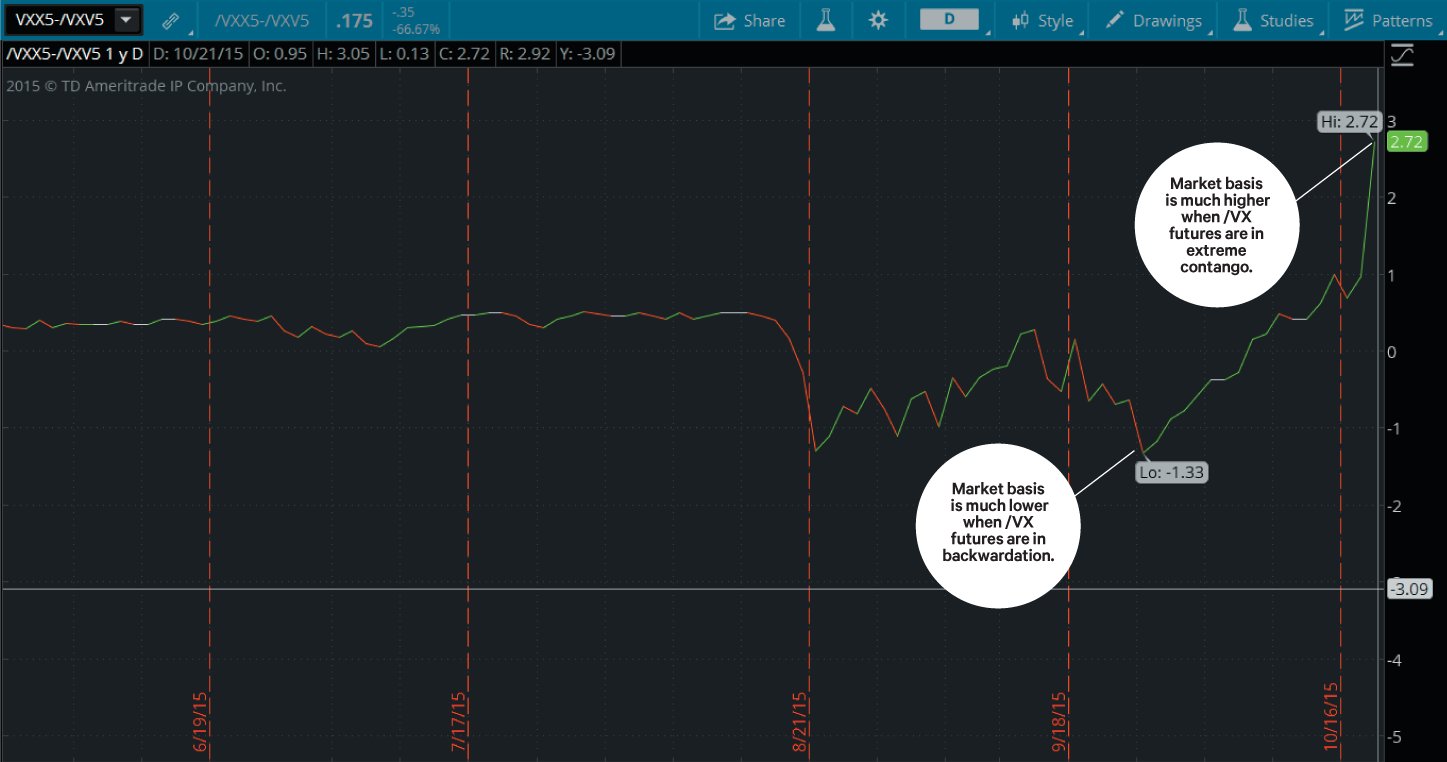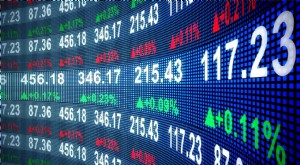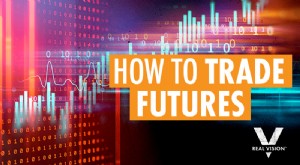Como negociar futuros em 3-D:negociação básica
Os futuros podem ser uma forma direta e eficiente em termos de capital de especular ou fazer hedge. Você acha que o preço do milho está subindo? Comprar um contrato futuro de milho / ZC é uma maneira mais fácil de apostar do que comprar uma fazenda de milho e plantar a sua própria. Que tal um hedge de curto prazo em um grande portfólio de ações S&P 500, um pouco antes de um anúncio do Fed? / ES S&P 500 futuros se encaixam nessa conta. Assim como ações, os futuros podem ser negócios de longo prazo ou couro cabeludo rápido. Mas, ao contrário das ações, os futuros também podem oferecer diferentes oportunidades de negociação por causa de sua base, que poucos comerciantes iniciantes conhecem.
Base 101
“Base” é o termo para a diferença nos preços futuros em diferentes vencimentos, ou o preço à vista (“à vista”) do produto subjacente e o preço futuro. Os preços de futuros nos vários vencimentos são diferentes uns dos outros e o preço à vista por causa do custo de transporte, e o impacto da oferta e da procura. Essa diferença representa a base. / ES futuros, por exemplo, têm contratos que expiram em março, Junho, Setembro, e dezembro. / ZC futuros de milho têm contratos que expiram em março, Poderia, Julho, Setembro, e dezembro. / Ligações ZB, / GC ouro e, Os futuros do petróleo bruto / CL têm seu próprio conjunto de vencimentos.
Base de Negociação
Em um mundo, negociação básica é comprar um futuro em um mês de expiração, e vendê-lo em um mês de vencimento diferente - como vender março / ES e comprar junho / ES. É como a negociação de pares intermercados, mas com quase 100% de correlação. Você está especulando com base no aumento e na ampliação, ou diminuindo e estreitando. Porque os dois futuros são baseados no mesmo subjacente (por exemplo, S&P 500, Obrigações do Tesouro, óleo cru, etc.), eles são altamente correlacionados. Eles tendem a se mover para cima e para baixo ao mesmo tempo. Mas quando eles não se movem ao mesmo tempo, ou pelo mesmo valor, a base muda.
Porque a base pode ser negativa, onde o preço do futuro de expiração posterior é menor do que o preço do futuro de expiração mais próximo (também conhecido como "backwardation"), é importante saber de que maneira você acha que o futuro a curto prazo pode se mover, em relação ao futuro do mês anterior. Alguns futuros como / ES estão regularmente em retrocesso, portanto, o alargamento da base significa que se torna mais negativo. Se você pensou que iria se alargar, você pode considerar comprar o futuro de curto prazo e operar a descoberto no futuro do mês anterior (por exemplo, você compraria março / ES e curto junho / ES).
Quando o preço de futuros com vencimento adicional é mais alto do que os futuros com vencimento mais próximo, isso é chamado de "contango". No contango, a base é positiva. Se / CL futuros estão em contango, e você pensou que a base iria se alargar, você pode considerar encurtar o próximo mês / futuro CL, e comprando o futuro do mês anterior / CL.
4 etapas para obter a base
Para negociar a base, você tem que ver a base. Com isso, thinkorswim ® você está coberto.
1. Na guia Comércio da thinkorswim ® , você pode ver os vencimentos de futuros disponíveis digitando o símbolo de raiz (por exemplo, / ES) e selecionando “Todos” no menu suspenso.
2. Para ver o preço base entre as expirações consecutivas de futuros, clique no menu suspenso “Spread” e selecione “Agenda”.
3. Clique na seta ao lado de um dos futuros para expandir o preço base, que é a expiração posterior (ou retrógrada), menos a expiração mais próxima.
4. Com base no preço base que você acabou de abrir, você pode traçar a base clicando com o botão direito do mouse em “=” antes do símbolo de futuros, e seguindo o caminho de clique “Mais informações…”> Gráficos TOS> quadrado superior esquerdo no menu de grade do gráfico.
FIGURE 1: Source:thinkorswim by TD Ameritrade. Apenas para fins ilustrativos.
Basis Trading In the Real World
You may consider the futures basis because they can be traded by themselves, kind of like stocks pairs trades. Por exemplo, maybe you don’t have a bullish or bearish bias on the futures’ underlying product itself. But considering the futures basis, you think it might move higher or lower.
Trading the futures basis also has potential advantages over stock pairs trading. Primeiro, the contract and tick size are the same for a given future. You don't need to adjust the quantities of the trade to account for different contract specification. Segundo, the margin requirement for the basis trades can be lower than for a single long or short future because the basis trade is simultaneously long and short futures. The basis tends to have smaller price changes than the individual future would. So the margin requirement is also smaller.
Let’s look at three futures basis trading scenarios.
Crude Oil (/CL)
Crude oil futures contracts typically go out a couple of years. They’re one of the most liquid, actively traded futures contracts, and the basis can move around a lot. To understand why, think about how crude oil gets turned into gasoline and other “stuff.” It gets pumped out of the ground and transported to a refinery, and that costs money. If the oil is stored, there are insurance and storage fees, as well as interest charges if you’re borrowing money to buy it.
All those things go into the basis of /CL futures, and would make the further-term futures more expensive than near-term futures because those costs are built into the futures’ prices. But with the futures basis, there’s also the expectation of over- or under-supply in the coming months and years. You can see that when you look at /CL futures prices. Backwardation in /CL can happen when the market sees a shortage in crude oil, and where near-term demand outstrips immediate supply. The price of the near expiration /CL future is pushed higher than the back month. But /CL is more often in “contango, ” where the carry costs make the back months slightly higher than the near months, and there is Backwardation in /CL can happen when the market sees a shortage in crude oil, and where near-term demand outstrips immediate supply. The price of the near expiration /CL future is pushed higher than the back month. But /CL is more often in “contango, ” where the carry costs make the back months slightly higher than the near months, and there is equilibrium between supply and demand. If you see /CL in backwardation and you think the causes are temporary, and that /CL will move back to contango, you could consider shorting the near-expiration /CL and buy the further-expiration /CL. O risco, claro, is that /CL could move further in backwardation, resulting in a loss on the trade. And there’s never a guarantee that contango has to happen in the future. But the trade could be profitable if the futures move back to contango before the expiration of the near-term future.
S&P 500 Index (/ES)
One of the most widely watched and actively traded futures is the /ES contract based on the S&P 500 stock index. /ES trades until 3:15 p.m. CT during “regular” market hours. The price of /ES is based on the value of the stocks in the S&P 500 (which is the SPX index), and the cost to carry the portfolio of those stocks. There is an interest charge to borrow money to buy shares. The interest is offset by dividends that are paid by the S&P 500 stocks.
The net impact of interest and dividends determines the basis between the / ES and the SPX. Nowadays with interest rates low relative to dividends, /ES futures are usually in backwardation, and the basis doesn’t fluctuate much. But because S&P 500 stocks stop trading at 3:00 p.m. CT, tão, também, does the price of the SPX stop updating. And in the 15 minutes between 3:00 p.m. and 3:15 p.m., when the /ES continues to trade, it can move higher or lower than what the basis calculation would suggest based on news that arrives after 3:00 p.m., or on the opening of large positions in /ES in the last 15 minutes of trading that anticipate the next day’s price movement.
If the /ES to SPX basis is $-10, when the /ES moves up relative to where SPX closed and makes the basis $-8, por exemplo, that can signal a stronger open the next day. If / ES moves down relative to the SPX closing price to make the basis $-12, that can signal a weaker open the next day. Looking at the /ES to SPX basis before and after 3:00 pm can give you a clue as to the next day’s opening price action. This may impact stop orders, and even technical indicators you might be tracking.
CBOE Volatility Index (/VX)
Volatility futures might be the trickiest to understand. But they might offer the most interesting opportunities. The CBOE Volatility Index (VIX) is derived from the out-of-the-money SPX option prices. When traders anticipate larger price changes in the SPX (i.e. more volatility), the out-of-the-money SPX option prices can increase in price. That, in turn, pushes up the VIX. When traders anticipate smaller price changes in the SPX (i.e., lower volatility), the out-of-the-money SPX prices can drop, which in turn drives the VIX lower.
You can’t trade the VIX directly, and /VX futures are a way to speculate on the direction of volatility. But /VX futures are only modestly tied to the VIX. “Modestly” because /VX settles to the VIX settlement value at their expiration. But there isn’t any cost of carry between the VIX and /VX futures be- cause you can’t buy the VIX like you can buy crude oil or a stock portfolio. That makes /VX futures pure indications of how much future volatility the market anticipates. The basis you see between the near and further month in /VX futures reflects whether the market sees more volatility near term or longer term.
Most of the time /VX futures are in contango—where the market expects more volatility the further into the future you look. But when the market panics and drops, generally the VIX rallies the most, the closest expiration /VX future rallies a bit less, and further expiration /VX futures rally a little less than those. That can push /VX futures into backwardation, and make the basis negative.
Figure 2 charts just this scenario, when a market dropped and pushed volatility higher, and the /VX basis became negative.

FIGURE 2:NEGATIVE BASIS
To view basis on /VX, you have to enter it manually as a pair (i.e., longer-term future minus shorter-term future, or /VXX5-/VXV5 as shown above). A maior parte do tempo, /VX futures are in contango, as was the case prior to August in the chart. Source:thinkorswim by TD Ameritrade. Apenas para fins ilustrativos.
A maior parte do tempo, the price of the back-month /VX future is higher than the price of the near-month /VX future, and the basis is positive. When the market became more volatile, the basis became negative. If you believe the market will calm down, and the front-month /VX will drop relative to the back month, and the basis will go from negative to positive, you could consider shorting the front-month /VX future and buy the backmonth /VX future. That trade could be profitable if the basis goes from negative to positive. But the trade would lose money if the basis became more negative—which is something that happened in the 2008 market crisis.
At the closing bell, /VX basis trading isn’t for the faint of heart. If you’re already a proficient futures trader, consider this another tool in the strategy toolbox. But even if you’re not ready to trade it, /VX basis can certainly offer you clues as to how the market is forecasting volatility.
Open a Futures Account
For qualified accounts, you’ll need Level 3 options approval to trade futures. Faça login em sua conta em tdameritrade.com. Under the Trade tab, go to Futures &Forex for more information.
Negociação de futuros
-
 Como negociar ações
Como negociar ações p Negociar com ações pode parecer glamoroso, mas nos bastidores é realmente muito trabalho duro e pode envolver uma extensa pesquisa. Embora nem sempre seja fácil, novos investidores podem tomar uma s...
-
 Como Começar a Negociar Futuros
Como Começar a Negociar Futuros Por:Wayne Duggan Para os traders mais novos, os contratos de futuros podem parecer um mercado complicado, reservado apenas para traders experientes. Mas os futuros são como qualquer instrumento d...


